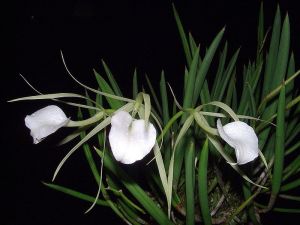No edit summary |
No edit summary Tag: wikieditor |
||
| (8 intermediate revisions by the same user not shown) | |||
| Line 1: | Line 1: | ||
[[File:Brassavola_nodosa.jpg|thumb|Brassavola nodosa]] | [[File:Brassavola_nodosa.jpg|thumb|''Brassavola nodosa'' (not my photo)]] | ||
'''Code:''' B.0x0000 (2009-05-17) | |||
'''Common Name:''' Lady of the Night, Knobby Brassavola<br /> | '''Common Name:''' Lady of the Night, Knobby Brassavola<br /> | ||
| Line 10: | Line 12: | ||
This hardy, medium sized, hot growing epiphyte or lithophyte has cylindrical, short stems enveloped by scarious sheaths with a single, sub-terete, sulcate,acute-apiculate leaf. It has a nice, citrus fragrance at night and the flowers are close to 4" across and occur in the spring and summer but are possible at any time on a 20cm long, bracteate inflorescence that arises on a newly maturing pseudobulb that carries a single, long, sub-terete leaf that carries up to 6 flowers. They are found in Mexico, Guatemala, Belize, El Salvador, Honduras, Nicaragua, Costa Rica, Panama, Cayman Islands, Aruba, Curacao, Bonaire, Puerto Rico?, French Guiana, Suriname, Guyana, Venezuela, Colombia and Brazil from sea level to about 500m as epiphytes or lithophytes and can be quite salt tolerant. | This hardy, medium sized, hot growing epiphyte or lithophyte has cylindrical, short stems enveloped by scarious sheaths with a single, sub-terete, sulcate,acute-apiculate leaf. It has a nice, citrus fragrance at night and the flowers are close to 4" across and occur in the spring and summer but are possible at any time on a 20cm long, bracteate inflorescence that arises on a newly maturing pseudobulb that carries a single, long, sub-terete leaf that carries up to 6 flowers. They are found in Mexico, Guatemala, Belize, El Salvador, Honduras, Nicaragua, Costa Rica, Panama, Cayman Islands, Aruba, Curacao, Bonaire, Puerto Rico?, French Guiana, Suriname, Guyana, Venezuela, Colombia and Brazil from sea level to about 500m as epiphytes or lithophytes and can be quite salt tolerant. | ||
Latest revision as of 16:06, 11 June 2024

Code: B.0x0000 (2009-05-17)
Common Name: Lady of the Night, Knobby Brassavola
Scented: yes, citrus
Light Requirements: partial sun
Temperature Requirements: intermediate to hot
Blooms: mostly spring and summer
Flower Size: 8.75cm
Synonyms: Bletia nodosa Rchb.f 1861; Bletia rhopalorrhachis (Rchb.f.) Rchb.f. 1862; Brassavola gillettei Jones 1967; Cymbidium nodosum Sw. 1799; *Epidendrum nodosum L. 1753
This hardy, medium sized, hot growing epiphyte or lithophyte has cylindrical, short stems enveloped by scarious sheaths with a single, sub-terete, sulcate,acute-apiculate leaf. It has a nice, citrus fragrance at night and the flowers are close to 4" across and occur in the spring and summer but are possible at any time on a 20cm long, bracteate inflorescence that arises on a newly maturing pseudobulb that carries a single, long, sub-terete leaf that carries up to 6 flowers. They are found in Mexico, Guatemala, Belize, El Salvador, Honduras, Nicaragua, Costa Rica, Panama, Cayman Islands, Aruba, Curacao, Bonaire, Puerto Rico?, French Guiana, Suriname, Guyana, Venezuela, Colombia and Brazil from sea level to about 500m as epiphytes or lithophytes and can be quite salt tolerant.